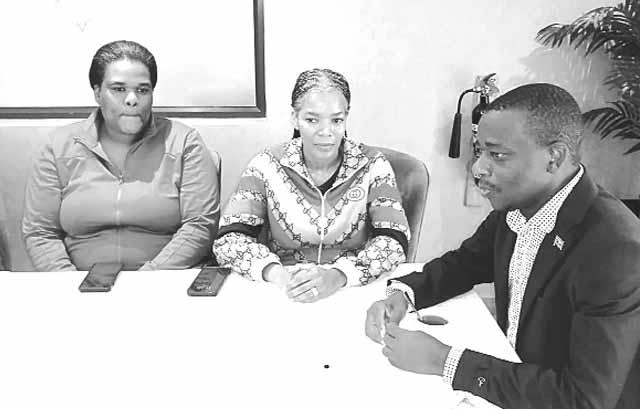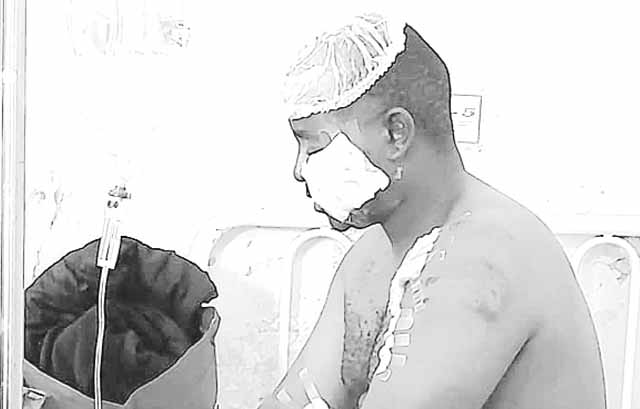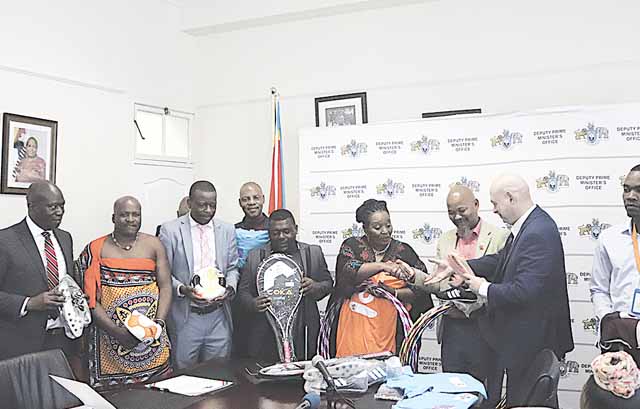By Samkelo Mahlalela | 2019-09-20

Eswatini has set a target of ending AIDS eight years earlier than the global time frame, as part of His Majesty King Mswati III’s vision of ‘A First World Eswatini by 2022”.
Recent evidence indicates that the country is on the right trajectory to reach this target. The Swaziland HIV Incidence Measurement Survey (SHIMS) 2, 2016/2017 reported that massive scale-up of prevention interventions, HIV testing, and treatment had slashed the rate of new infections (HIV incidence) by 44 per cent since 2011.
94 per cent of HIV positive mothers receive HIV treatment to prevent transmission of the virus to their children during pregnancy and childbirth. The country had also reduced AIDS-related deaths by more than 50 per cent between 2006 and 2016; with 70 per cent of those living with HIV receiving antiretroviral treatment (ART), and retention of people on treatment after one-year standing at 93 per cent – one of the highest retention rates in the world.
HIV incidence among adults ages 15 years and older was 1.36 percent – 1.70 per cent among females and 1.02 per cent among males. Among adults 18-49 years, HIV incidence was 1.39 per cent, nearly half of the prior 2.48 per cent HIV incidence rate in 2011.
The percentage of all HIV-positive adults with viral load suppression (VLS), an indication that the infection is under control, was 73.1 per cent, with 76.0 among females and 67.6 per cent among males.
The VLS was estimated using all people living with HIV (PLHIV) as a denominator, regardless of knowing their HIV status or use of antiretroviral drugs. Among all HIV-positive adults aged 18-49 years, twice as many (71.3 percent) were virally suppressed in SHIMS 2 as compared to SHIMS 1 (34.8 per cent) in 2011.
These results indicate that Eswatini has made substantial progress towards achieving all three of the 90-90-90 global targets set by the Joint United Nations Programme on HIV/AIDS (UNAIDS) to help end the HIV epidemic.
However, the country is still faced with major challenges, none more concerning than that, even with the HIV prevalence stabilised at 27 per cent in people aged 15-49 years, HIV prevalence remains high. National survey data shows that adolescent girls and young women (AGYW) face significantly greater risk of HIV than their male peers, with young women ages 20-24 years, five times more likely to be infected than young men of the same age – 20.9 per cent compared to 4.2 per cent. One in every five young women 20-24 years is HIV positive, increasing to one in every three for women 25-30 years.
HIV response to intensify efforts to address key populations’ issues
HIV prevalence among adolescents and young people is an indicator of new infections acquired rather than a survival effect of the treatment programme. Evidence also shows that most HIV infections in Eswatini are transmitted heterosexually, although risk factors vary.
In AGYW, sex workers, men who have sex with men, people who inject drugs, transgender people, and prisoners are disproportionately affected by HIV.
Key populations are particularly vulnerable to HIV infection due to their high-risk sexual behaviour and higher internal and external stigma and discrimination, which constitutes a major barrier to their service uptake. HIV prevalence among FSW is estimated at 60.5 per cent while prevalence among MSM is 12.6 per cent.
On the other hand, prevalence of syphilis among MSM was 1.2 per cent and 6.6 per cent among female sex workers (FSW). Gender inequalities, differential access to services, and sexual violence increase women’s vulnerability to HIV, especially younger women, who are biologically more susceptible to HIV.
In responding to issues of these key affected populations, the country’s HIV response is intensifying efforts to address human rights and gender-related barriers to service access and to ensure appropriate focus on interventions that respond to them.
The response has taken a more location and population-specific prevention approach and aims to provide tailored and differentiating services for key and vulnerable populations in underserved and / or high-burden regions and Tinkhundla.
This talks to a significantly enhanced focus on HIV prevention, including linkages to Sexual Reproductive Health (SRH) and Gender Based Violence (GBV) services, among adolescents and young people - especially highly vulnerable adolescent girls and young women.
The success of this paradigm shift, however, will rely on all involved playing their part, starting with ensuring that each liSwati (in targeted key populations or not) recognises his/her HIV risks and accesses appropriate services to minimise their vulnerabilities or even completely remove them.
Common HIV risks and what you can do
The many years of responding to the HIV and AIDS epidemic in the country (and indeed globally) has shown that there is no magic bullet for HIV prevention, making it imperative that as a nation, we all embrace the different combination prevention interventions – which rely on individuals having an appreciation of their personal HIV risks.
As HIV transmission in Eswatini is mainly through heterosexual activity, many of the common HIV risks are closely linked to sexual behaviour. These include:
n Viral load - The higher someone’s viral load, the more likely that person is to transmit, as it means there are more HIV particles in the body, leading to health problems and making one more likely to transmit HIV to sexual and drug-using partners.
Getting in care and adhering to treatment regimens offers the greatest chance to get and stay virally suppressed, live a longer, healthier life and reduce the chance of transmitting HIV to your partners. If you are HIV negative and have an HIV-positive partner, encourage the partner to get in care. Also, use a condom the right way every time you have sex and / or take daily Pre-Exposure Prophylaxis (PrEP) to prevent HIV.
n Sexually transmitted Infections (STIs) – Many people with STIs may not know they have one as they may not have symptoms. Some common symptoms include: discharge from the vagina, penis, or anus; Pain or burning sensation when urinating or having bowel movement; and sores or ulcers on your penis, vagina, or anus. The only way to know for sure, is to get tested. If you have an STI, you are more likely to get HIV from someone who is HIV-positive or transmit HIV to others – if you are also HIV-positive.
Finding out if you have an STI and getting treatment can lower your chances of getting or transmitting HIV and other STIs, so if sexually active, there is need for you and your partner(s) to get tested for STIs – including HIV, if HIV-negative – regularly, even if you do not have symptoms. Always use a condom the right way, every time you have sex to protect yourself from STIs that can be transmitted through genital fluids.
n Having a different HIV status than your partner – It is important to be open with your partner about your HIV status and ask the same of them. If HIV-negative, having sex with a partner who is HIV-positive increases the chances of getting HIV, and each time you have sex with the person, the risk of being exposed to their infection goes up.
There are many actions you can take to lower your risk of acquiring or transmitting HIV if your partner’s HIV status is different from yours, including: using condoms the right way each time you have sex, taking daily PrEP to prevent HIV, and encouraging your partner to take medicine to treat HIV and stay virally suppressed. The more actions you take, the safer you can be.
n Having Multiple Sexual Partners – If you and / or your partner have sex partners that overlap in time, the risk of getting or transmitting HIV or other STIs increases. This is because the more sexual partners you have in your lifetime, the more likely you are to have a sex partner who has HIV and whose viral load is not suppressed or who has another STI.
Not having sex is the best way to prevent getting or transmitting HIV. However, because humans are sexual beings by nature, you can choose to have fewer partners in the future. You can also choose sexual activities that are lower risk for HIV than anal or vaginal sex.
A monogamous relationship, which means that both you and your partner are having sex only with each other, can also reduce your risk of infection. Also, sexual activity should be planned for, and not just happen. Talking openly and frequently with your partner can help make decisions on the inclusion of safe sex tools that may decrease risk of getting or transmitting HIV.
n Power differences in sexual relationships – These can be harmful to the relationship and each partner. Sometimes people do what their partners want because they are afraid of their partner’s reaction, for example, one partner may be afraid to ask the other to wear a condom during sex, and thereby increasing chances of getting or transmitting HIV.
Think about how power affects your relationship and the things you do for your sexual partner. If you can, talk to your partner about your preferences before you have sex. Talking openly is important to getting what you need in a relationship and staying healthy.
However, if you feel threatened or have experienced violence in the relationship, you may need help from a counsellor, on ways to talk to your partner or finding resources to get out of the abusive relationship. Communicating with your partner, managing uncomfortable emotions like anger and jealousy, and treating others with respect, are a few ways to keep relationships healthy and non-violent.
NB: Alcohol and drug abuse as an HIV risk will be discussed as a stand-alone, in a follow-up article.
share story
Post Your Comments Below

MINISTER of Sports, Culture and Youth Affairs Bongani Nzima met with Ferguson Films Executive Pro...

Tragedy befell Hlane Royal National Park on Sunday when two guides were attacked and mauled by a ...

SPORTS - SO generous!
The European Union and UNICEF, through the Deputy Prime Minister's off...

As His Majesty King Mswati celebrated 56th birthday, the tetfulo event bore witness t...
All material © Swazi Observer. Material may not be published or reproduced in any form without prior written permission.
Design by Real Image Internet